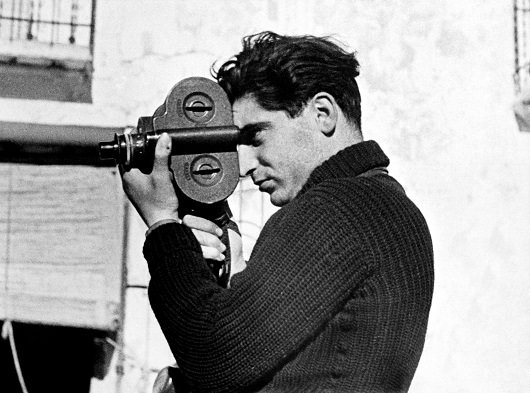Robert Capa: The Hungarian American Legendary War Photographer
zita kisgergely
Robert Capa is celebrated as one of the greatest war photographers in history. Born Endre Ernő Friedmann on October 22, 1913 in Budapest, Hungary, his groundbreaking work across the globe depicting up close the harsh reality and chaos of war created a legacy in combat photography that left a profound impact on the field. We take a broad look at Capa's journey from a young boy in Hungary to iconic figure in photojournalism.
Robert Capa during the Spanish Civil War, 1937. Photo by Gerda Taro.
Early life and influences
Born into a Jewish family in Budapest (Capa’s parents, Júlia Berkovits and Dezső Friedmann, were tailors who ran a successful shop), Capa's early education took place at a Lutheran elementary school and later at Madách Secondary School in Budapest. His interest in journalism is said to have been influenced by Hungarian writer Lajos Kassák. In 1931, due to his involvement in leftist activities and subsequent imprisonment, Capa left Hungary and began his journey across Europe.
The birth of Robert Capa
After leaving Hungary, Capa initially moved to Berlin where he studied journalism and worked as a photo lab assistant. But the rise of the Nazi regime forced him to flee to Paris in 1933. It was there that he and fellow photographer Gerda Taro had the bright idea of adopting the name Robert Capa to enhance the marketability of his work. It was far easier–and more lucrative–to sell photographs snapped by a fictitious famous American photojournalist travelling Europe than as a no-name Eastern European refugee.
Iconic works
Capa's first breakthrough came in 1932 when he photographed Leon Trotsky in Copenhagen. But it was his coverage of the Spanish Civil War from 1936 to 1939 that solidified his reputation. During this time, he befriended Ernest Hemingway, who was in the country on assignment for Life. When the magazine ran a story on Hemingway’s time in Spain, Capa’s photographs were included in the spread.
Perhaps one of the most iconic and controversial images of the war, "The Falling Soldier" was captured by Capa at the very moment a soldier was shot. Despite debates over its authenticity, the photo remains a powerful symbol of the conflict.
The Falling Soldier by Robert Capa, 1936.
During World War II, Capa covered various fronts, including London, North Africa, Italy, and France. He was the only civilian photographer to land on Omaha Beach during D-Day; his pictures of the event still have a movingly haunting quality. The images from that day are known as "The Magnificent Eleven" because only eleven photographs were successfully developed; the rest were allegedly destroyed in a dark-room accident.
Landing of US-troops on D-Day in Normandy, France 1944. Photo by Robert Capa.
Post-war achievements & rubbing shoulders with celebs
In 1947, Capa co-founded Magnum Photos with Henri Cartier-Bresson, David Seymour, George Rodger, and William Vandivert. Magnum Photos became the first cooperative agency for freelance photographers, providing a platform for many legendary photojournalists which allowed its members to retain copyright of their photographs. Capa stated, “Why be exploited by others? Let’s exploit ourselves.” The cooperative is still operational today.
But Capa was not just about the seriousness of his subject matter. He was a very social being with a large group of friends–many of whom were celebrities of the time. He knew Pablo Picasso and his family, and he famously had a year-long affair with Ingrid Bergman (the relationship was kept under wraps from the public as Bergman was still married at the time). It was after Capa followed her to Hollywood that he became a bona fide American citizen in 1946.
Pablo Picasso & Francoise Gilot, Golfe-Juan, France, August 1948. Photo by Robert Capa.
Capa continued to work, his pictures often reflecting a deep empathy and ability to capture the human spirit. His collaboration with writer John Steinbeck on "A Russian Journal" in 1947 is a notable example. As the pair travelled through Russia, Capa's photos complemented Steinbeck's narrative, offering a vivid visual portrayal of life in the Soviet Union. This would later, however, draw the attention of the FBI, who had been keeping a file on Capa since the 1930s. He was questioned and forced to make a statement saying he had never been a member of the Communist Party and was furthermore restricted from visiting any other countries behind the Iron Curtain.
Final years and legacy
In 1954, Capa accepted an assignment from Life magazine to cover the First Indochina War. On May 25, while accompanying a French regiment in Thái Bình Province, Vietnam, Capa stepped on a landmine and was killed instantly. He was 40 years old.
A 15-year-old Chinese soldier, pictured in the Battle of Wuhan, 1938, by Robert Capa. Photo via Wikipedia.
Capa's influence on photojournalism has been significant. His famous dictum, "If your photographs aren't good enough, you're not close enough," encapsulates his approach to capturing the immediacy of war–at any cost.
His younger brother, Cornell Capa, worked relentlessly to preserve Robert's legacy, founding the International Centre of Photography in New York City in 1974.
You can visit the Robert Capa Contemporary Photography Centre in Budapest where a permanent exhibition explores the major stages of his life through the 138 photographs on display. The Centre also hosts temporary photographic exhibitions and events.
Sources & further reading:
Flatpack Films has years of experience servicing international brands, agencies, and production companies. Filming in Hungary is easy when relying on their knowledge of the market and ability to solve complex needs. They bring the best that Hungary has to offer in terms of unique locations, exceptionally skilled crews, top-of-the-line equipment and technical solutions. Backed by an impeccable track record, Flatpack Films has worked with world-class clients including Samsung, Samsonite, Toyota, Braun, Chivas Regal and many more.
Get in touch and learn more about Budapest film locations, Hungarian film incentives, film tax credits in Hungary and how Flatpack Films can bring your project to life through a highly bespoke approach.




